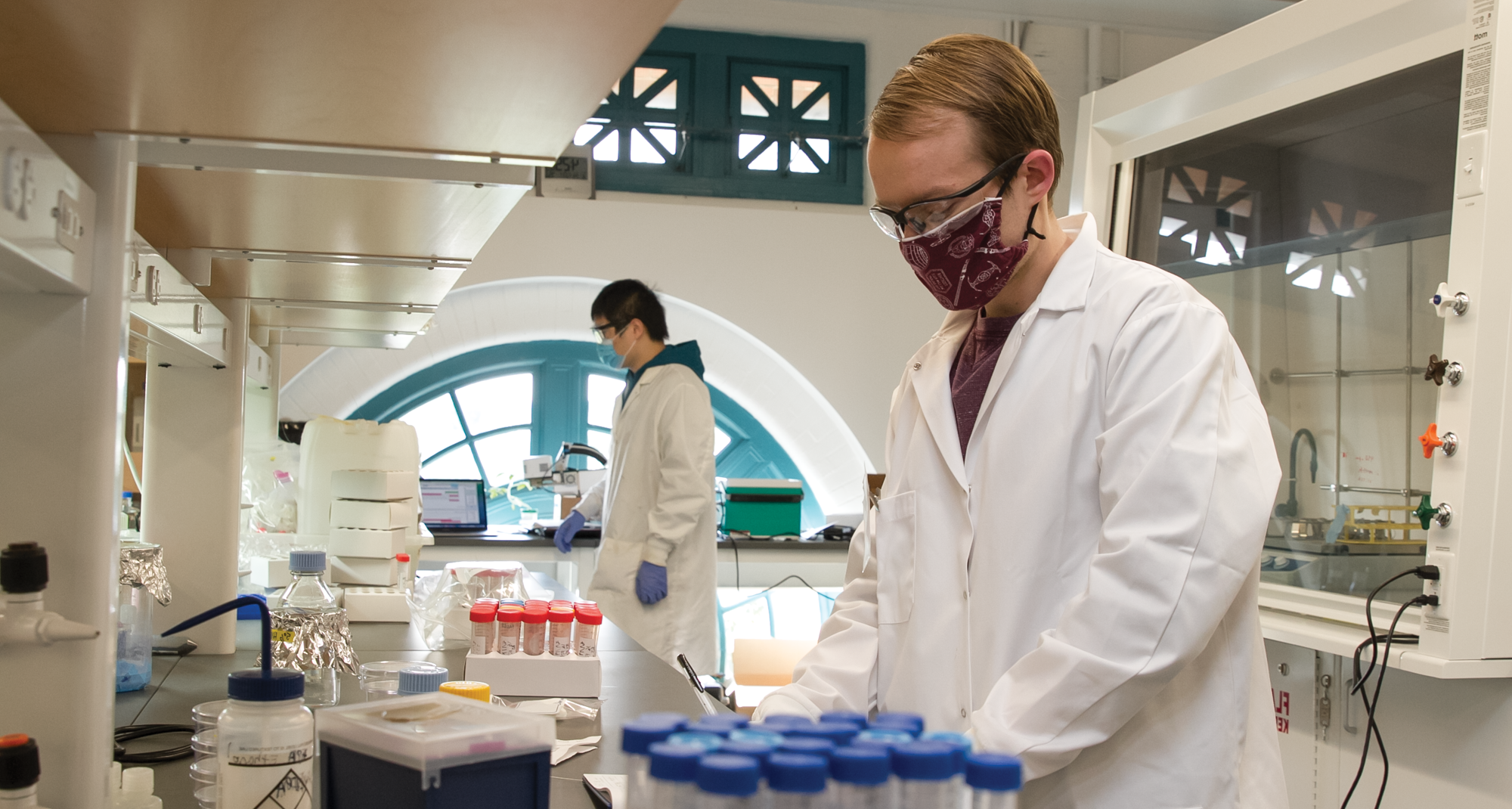
A Home for Innovation & Collaboration
Amidst a changing climate and a growing population, society must rise to meet ever-evolving environmental sustainability challenges. CEE faculty and students have long been working to study and address these issues, but, now, a renovated environmental engineering lab space is enabling research to progress more efficiently and collaboratively than ever before.
“Our new facility is a next-generation facility for environmental studies of water, soil, energy, climate, and agriculture. This open, bright, and flexible space is optimal for a rapid response to the research needs for current and emerging environmental challenges,” says Professor Kelvin Gregory, one of the CEE Professors who will conduct research inside the new labs. The labs are also essential to supporting the research and students of CEE Professors David Dzombak, Greg Lowry, David Rounce, Jeanne VanBriesen, and other faculty members.
Last renovated in 1994, the new 6000-square-foot facility on the second level of Porter Hall began welcoming students at the start of 2020, featuring a spacious layout that highlights the building’s original brick walls and natural light flowing through the arched windows. Inside, where there were once three walled-off rooms, a large central area now runs the length of the lab. Here, faculty and students have 12 state-of-the-art workstations with fume hoods and drop-down power from the ceiling, designed to accommodate the department’s changing needs for years to come.
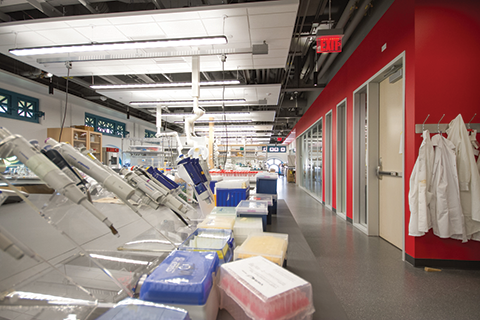 “This openness helps in the cultivation of new lines of investigation, because everyone—faculty, post-docs, graduate students, and undergraduate students—are interacting directly in a way that is conducive to an exchange of ideas,” says Gregory. Directly attached to the main area are a separate biological lab, microscope room, analytical instrumentation room, mercury analysis room, and elemental analysis room.
“This openness helps in the cultivation of new lines of investigation, because everyone—faculty, post-docs, graduate students, and undergraduate students—are interacting directly in a way that is conducive to an exchange of ideas,” says Gregory. Directly attached to the main area are a separate biological lab, microscope room, analytical instrumentation room, mercury analysis room, and elemental analysis room.
“After 25 years of heavy use and a lot of good work in the labs, these updates were imperative to being able to continue to attract top faculty, staff, and students and also to do state-of-the-art work,” states Department Head Dave Dzombak. “Now we have a facility that is designed to the latest laboratory standards and innovations and that positions us to compete with the strongest programs in the United States and across the world in the environmental engineering science domain.”
In addition to investments from the CEE Department, the lab redesign was made possible through generous support from the University, the College of Engineering, the Hillman Foundation in Pittsburgh, and multiple CEE alumni. Throughout the lab, several alumni have been recognized for their gifts, with their names attached to various benches and spaces in gratitude for their help with achieving the department’s vision.
“Now we have a facility that is designed to the latest laboratory standards and innovations and that positions us to compete with the strongest programs in the United States and across the world in the environmental engineering science domain.”
- Dave Dzombak
With space previously used for storage reclaimed in the renovation, the labs gained additional square footage and also now connect to ANSYS Hall, giving researchers the benefit of elevator access. “The new lab is an amazing upgrade. There’s room for all the cool gadgets we have recently purchased, and there’s room to grow, so, as new devices come along that the department wants, we have the space,” says CEE Professor Greg Lowry. “When prospective students walk in and see this lab, they say, ‘Wow. I want to work there!”
Among the newer, more cutting-edge instruments in the lab is a single-particle inductively-coupled-plasma Time-Of-Flight Mass Spectrometer (ICP-TOFMS), which allows researchers to determine the multi-elemental composition and mass of individual nanoparticles recovered from soil, plants, water, and other sources. “It gives you very particle-specific chemistry information as opposed to having to rely on an average of millions of particles,” Lowry explains. “The instrument we own was the first of its kind in North America, and, for the first year we had it, it was the only one in the United States.”
Currently, PhD student Garret Bland is using the ICP-TOFMS to study metal-based engineered nanomaterials (ENM) found in soil. His research is funded by the US Army Research Office, which wants to understand the environmental impact of the ENMs they use for munitions, obscurants, self-healing materials, and other applications. Outside of the military, ENMs are also prevalent in many commercial and industrial products, and numerous questions linger about the long-term fate and effects of engineered nanoparticles.
Although nanoparticles are known to accumulate in the environment, one challenge to assessing and monitoring ENM risk has been measuring their concentrations in soil. Many of the most utilized nanomaterials—like titanium, iron, aluminum, and silica—are naturally abundant, and distinguishing between natural and engineered nanoparticles has historically been tricky. Bland’s research aims to provide a solution.
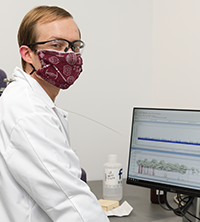 “With the ICP-TOFMS, I can produce a unique chemical fingerprint of an individual soil sample particle that—just like a human fingerprint—we can trace back to an engineered or natural nanomaterial,” says Bland. “My objective is to develop a framework that can identify ENMs, approximate ENM concentrations in soil, and determine the ENM source and age based on surrounding conditions. It’s essentially environmental forensics.”
“With the ICP-TOFMS, I can produce a unique chemical fingerprint of an individual soil sample particle that—just like a human fingerprint—we can trace back to an engineered or natural nanomaterial,” says Bland. “My objective is to develop a framework that can identify ENMs, approximate ENM concentrations in soil, and determine the ENM source and age based on surrounding conditions. It’s essentially environmental forensics.”
Having worked in the old lab and the new, Bland appreciates not only the increased interaction with fellow researchers, but also that the improved organization and ease of access to materials has helped him be more efficient. “It makes work go much smoother, so we’re able to do more experiments and more in-depth experiments in the new lab,” he reflects.
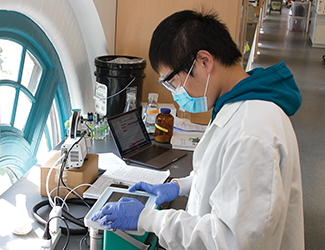 Among Bland’s peers in the lab is fellow PhD student Yilin Zhang, whose research—funded by the National Science Foundation—is rethinking how we deliver agrochemicals to crops. Today, chemical usage in agriculture is highly inefficient, causing significant nitrogen and phosphorus runoff and pollution. At the same time, the severity and length of heat waves is increasing, which can limit crop productivity, make plants more vulnerable to pathogens, and amplify the need for agrochemicals.
Among Bland’s peers in the lab is fellow PhD student Yilin Zhang, whose research—funded by the National Science Foundation—is rethinking how we deliver agrochemicals to crops. Today, chemical usage in agriculture is highly inefficient, causing significant nitrogen and phosphorus runoff and pollution. At the same time, the severity and length of heat waves is increasing, which can limit crop productivity, make plants more vulnerable to pathogens, and amplify the need for agrochemicals.
Zhang hopes to address both problems by using nanotechnology to deliver nutrients and antimicrobial agents in a way that is more targeted and responsive to stressors like heat and excess light.
Recently, Zhang successfully synthesized polymers that can deliver agrochemicals directly into plants, with the chemicals remaining dormant until they are activated by high temperatures to help the plant survive the heat.
“Our nanocarrier can release the agents at the right place—which is inside the plants—and also the right time—which is at higher temperatures when the plants are more vulnerable,” explains Zhang.
While plants normally use less than 5% of applied agrochemicals, this delivery method achieves 40% efficiency and Zhang hopes that number will continue to increase.
“In the old lab, we mostly worked in separate areas. Now, it’s much easier to talk with each other and share opinions. There’s more co-experimenting happening.”
- Yilin Zhang
For Zhang, the new lab has provided a more convenient and collaborative working experience. “In the old lab, we mostly worked in separate areas,” he shares. “Now, it’s much easier to talk with each other and share opinions. There’s more co-experimenting happening.”
Of course, as is standard for Carnegie Mellon, collaboration is key to many of the projects occurring in the new labs. Zhang, for example, is co-advised by Professor Lowry and Chemical Engineering Professor Robert Tilton.
Lowry and Dzombak are also working on a project with colleagues in Mechanical Engineering to develop robots that could do autonomous soil sampling and site characterization, helping companies and government agencies to identify contamination in large areas that are difficult to sample manually.
“The robot would drive around these areas, collecting and analyzing samples in the field, logging the data, and deciding where to go next based on what it knows and the last sample it took,” explains Lowry. “Not many people are doing it yet, but the AI and robotics advances made for things like the Mars Rovers can be used on Earth too.”
Other innovative research currently occurring in the lab includes developing new low-energy methods to treat highly concentrated brines from oil and gas production, with the goal of maximizing water recovery and reuse via a liquid-liquid extraction approach.
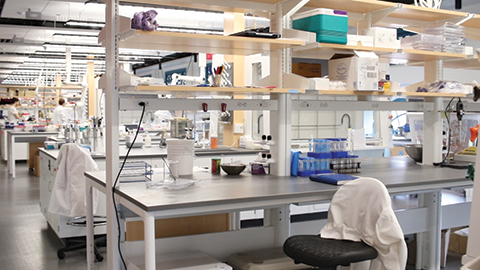 Beyond these research projects led by faculty and graduate students, CEE undergrads will use the lab for environmental engineering courses, independent research, honors projects, summer research projects, extracurricular activities, and more.
Beyond these research projects led by faculty and graduate students, CEE undergrads will use the lab for environmental engineering courses, independent research, honors projects, summer research projects, extracurricular activities, and more.
Additionally, some of the department’s sensing work has found a home inside the new facility. “This is a shared space among the faculty and students and that includes the entire department along with our colleagues across Carnegie Mellon,” says CEE Department Head Dave Dzombak.
Looking to the future, the new labs provide a platform for game-changing collaborations, developments, and research discoveries. “This facility will have an immense impact on graduate and undergraduate research in Civil and Environmental Engineering,” states Professor Kelvin Gregory. “Of course, collaborative interdisciplinary research is what we are best known for at Carnegie Mellon, so this facility will benefit not just the people in our department, but also all of those people that we partner with in the College and across the University.”